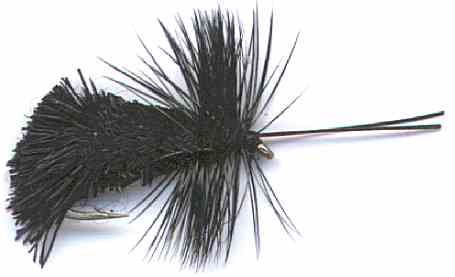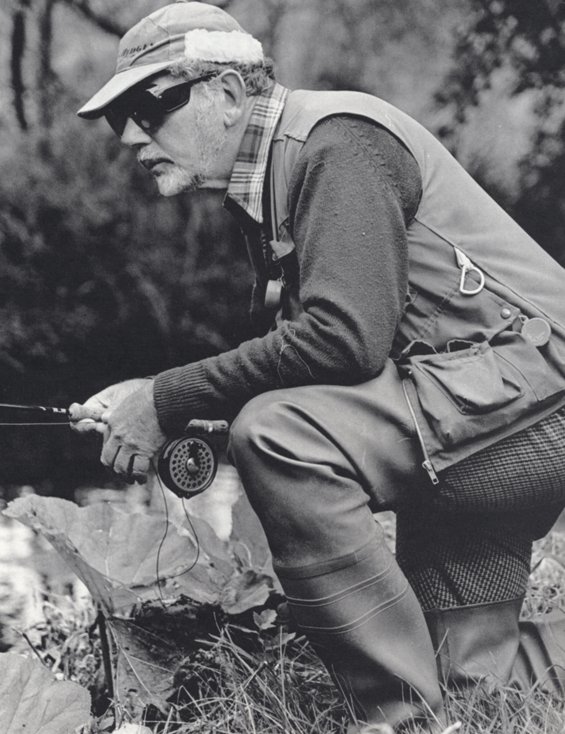Goddard's Black Caddis (G & H Sedge) Fly
If you like to go flyfishing for trout in a boat on Lakes and reservoirs then the Goddards Brown Caddis fly is ideal as a top dropper on a rig of three to four flies. It mimics a female caddis coming back to the water surface to lay eggs which fish find a tempting target.

GODDARD'S CADDIS FLY PATTERNS. Hook size 10 12 14 16 18 - $US each - Great for rough water
The Goddard's caddis with clipped hair body work great on fast water over big rocks where higher flotation and visibility is important. It also works well on quieter water, The trout looking up at the surface recognize the silhouetted shape of the clipped Goddard's Caddis as that of the natural caddis. On bright sunny days fishing on water that is reflecting the sunshine it can get difficult keeping track of your fly. Use a White Goddard's Caddis. If the sun goes in try a more natural colored Goddard’s caddis to match the local hatch like this on.
Originally this caddis imitation was called the 'G & H Sedge' (Goddard & Henry sedge) and still is in Britain. It was designed by the fly fishing entomologists Mr Goddard and Mr Henry after they had observed and studied the silhouette of caddis flies as they skittered invitingly over the water's surface during the later part of the day. They wound buoyant deerhair onto a hook and then sculptured the material until it matched the insect's wing and body shape. They ended up with a nearly unsinkable fly that when retrieved on the water surface produced a realistic wake. The trout loved it. It was a radical design when it was first published in fly fishing magazines and pattern books. To understand the design of this Caddis fly you need to know a little of the natural history of the caddis. When the caddis hatch the emergent adult tries to swim as fast as it can to the safety of the bank. In this mad dash for survival it creates a 'V' shaped wake a bit like a small speed boat. The trout are on the look out for this give away sign of fast food on the move and home in on these flies with some spectacular takes. The blunt stubby wings that copy the shape of the natural insects' wing cause a disturbance on the retrieve, in the water surface that mimics that caused by the scuttering adults.

Goddard's Caddis flies are not the answer to all your rising fish fly fishing situations. When the trout are sipping little blue winged olives from the water surface they will often ignore a large floating Goddard's. But during quiet periods without any major hatch underway the Goddard's Caddis is a great searching fly for drawing strikes from larger than average trout. The versatility of this fly is the key to its success. Fished dead-drifted over a rising trout will often draw a strike, but when this does not work the high floating characteristics means it can be skated, twitched or otherwise worked on the surface to get a response. Sometimes these tactics can draw slashing strikes from large fish as big trout hammer the fly with the same gusto of a big bass taking a surface deerhair popper.
I like to fish these flies down and across the stream. I use a reach-casting and then slack line technique to avid drag. When the line tightens in the current I twitch the fly briefly and then lower the rod tip to create slack and the momentary dead drift of the fly as if it is resting. I dress both fly and leader with floatant. The leader must be floating along with the fly or your twitches will drag the fly under. Sometimes I only dress the fly with floatant. The leader tippet sinks drawing the fly under when it is twitched. If you give it some slack at this point the deer hair will bob quickly back up to the surface in an action trout find irresistible. The Goddard's Caddis's extreme buoyancy means that it also works well as a strike indicator

This is fly fisherman John Goddard designer of the Goddard's Caddis (G and H Sedge)
The common or slang term ‘sedge’ originates from the fact that adult Caddis flies can often be found clinging to sedge grass near the waters. Sedge/Caddis flies have four wings. The forward pair are normally a little longer than those at the rear. At rest their wings lie close along the body in an inverted V shape. Caddis flies do not have tails but many have long antenna. The Latin name for this group of flies is ‘Trichoptera’. They pass through four stages in their development; egg, larva, pupa and adult. The eggs are laid by the adult female in large jelly mass, which often floats on the water surface and drift until they stick to some river side vegetation. Some species lay their eggs directly on vegetation.
The eggs hatch into larva in about 10-12 days. The Larvae produce a sticky substance and attach what ever material in on the river bed to their body. This offers protection and camouflage. The pupa stage lasts for several days. The fully formed pupa has middle body legs that it uses to swim to the surface to hatch. Some species choose the shore or vegetation to emerge rather than open water where they are easy prey for the trout.
CUSTOMER'S COMMENTS
I fish the rivers of the Welsh Boarders. Our fly fishing season begins with a good hatch of large dark olives which appear even on the coldest days. In late April the Grannom caddis appear in great numbers on some rivers. If you are fortunate to be on the water during a hatch of these small caddis sport can be fast and furious. I like to use your Black Goddard’s Caddis. I find it the most productive pattern. It catches trout after trout - John Langdon
CUSTOMER'S COMMENTS
There are many dark sedges and at least two black ones in the UK though not that common on large lakes and reservoirs. The exception to this is the black silverhorns caddis but I have noticed that trout do not take them with the same enthusiasm as other caddis. I use black Goddard’s deerhair caddis on all my local rivers late in the evening when a caddis hatch is on. I prefer using this fly rather than tent wing or elk hair caddis because I find the deerhair body land more gently on the water surface than the other two patterns. This is particularly useful when fishing calm pools on warm summer evenings. It reduces the chances of the trout getting spooked and swimming away to find a place to hide. - Jason Buckler


Goddard's fishing books

